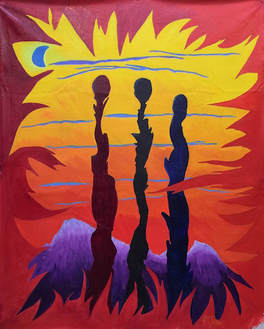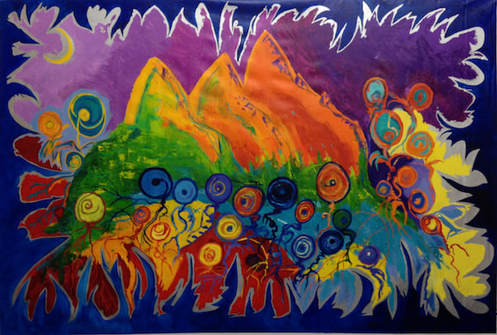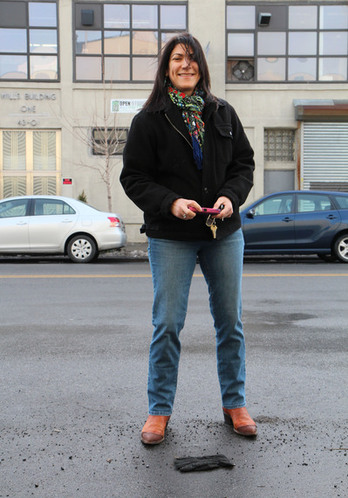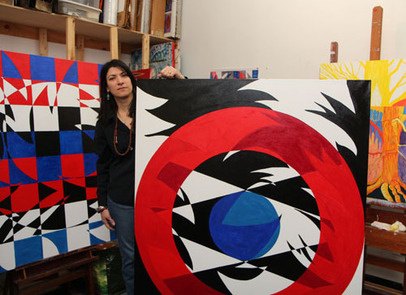Lisa Zilker: Dream Inspired Artist Painting a Perfect Picture ~ July 19, 2018
BY FULL ACCESS NYC ON 07/19/2018 ( LEAVE A COMMENT )By Nick Christophers
The art world has gone through many changes over the years since abstract / surrealist artist Lisa Zilker picked up a brush. Lisa was always in love with the arts; her grand-father was one of her main inspirations as he gave her, her first paint-box. She painted her first oil painting from that paint-box “Clouds” at age five from a dream. It was then that she realized that painting was her calling.
She attended the well-known art college The School of Visual Arts in Manhattan where she completed a BFA in Fine Arts and Art Education with a minor in Psychology. Her style of painting focuses on abstract expressionism and surrealism. Lisa’s work is very unique since every project carries a personal piece of Lisa in it.
“Many of my works are derived from my dreams and my meditation. I get very comfortable with the mediums I utilize to interpret my dreams. I use not earth tones instead I focus on intense colors.”
Since her time at SVA her work has been included in many solo and group exhibits. One of her favorite shows was a solo show at Tribeca Synagogue Gallery which was extended several times running from February thru June 2014. The show was even more special when it was given a 5 star review by well-known critic Jonathan Goodman. It was a key feather in Lisa’s artistic hat. That specific show was entitled “Conversations between Blue & Red”.
Aside from her shows she has also started her own business called “Canvas & Cocktails” which she started in 2016. “Canvas & Cocktails” is actually a class where people come together and paint with step by step instruction i.e. paint-night, Private parties, open groups & corporate team building events. It is an interesting concept since each participant creates their own interpretation of the piece. She has worked with students of all ages whether it is a corporate event or a private house party.
“It is a fun and enjoyable concept that many enjoy. My goal is to do more corporate events or even take on private students.”
Aside from her shows she has also started her own business called “Canvas & Cocktails” which she started in 2016. “Canvas & Cocktails” is actually a class where people come together and paint with step by step instruction i.e. paint-night, Private parties, open groups & corporate team building events. It is an interesting concept since each participant creates their own interpretation of the piece. She has worked with students of all ages whether it is a corporate event or a private house party.
“It is a fun and enjoyable concept that many enjoy. My goal is to do more corporate events or even take on private students.”
Lisa has had affiliation with some key organizations like American Alliance of Museums, Women’s Caucus of America, The National Arts Club and more. Her desire to assist others is also a big part of her life. Ever since she can remember she has been devoted to helping others. Lisa has offered her time to the Outreach Mentor Program, Job Path NYC for many years as a teacher for individuals with disabilities.
In 1998 she came up with a unique idea called the “post-card project” where she created and mail out post cards. She sent these cards to individuals who would then return them to her. After she received all of the cards she created a book which she is currently looking to publish. It is a beautiful assortment of art work along with literature that reflects the art work. The postcards recount day-to-day events, feelings & a three month road trip cross country are a collection of thoughts, feelings, poetry, experiences, proses and drawings.
She also has private and corporate collections in various parts of the world from New York to Australia. Lisa has also curated art shows at The National Arts Club and Bergen Medical Center. As far as gallery shows go, she has one coming up in September in Paterson, New Jersey at PAC “The Art Factory”. To get to know Lisa is to know her work which takes you on a journey into her dreams and thoughts. She is a one of a kind artist whose work grabs your interest from the first viewing.
https://fullaccessnyc.com/2018/07/19/lisa-zilker-dream-inspired-artist-painting-a-perfect-picture/
In 1998 she came up with a unique idea called the “post-card project” where she created and mail out post cards. She sent these cards to individuals who would then return them to her. After she received all of the cards she created a book which she is currently looking to publish. It is a beautiful assortment of art work along with literature that reflects the art work. The postcards recount day-to-day events, feelings & a three month road trip cross country are a collection of thoughts, feelings, poetry, experiences, proses and drawings.
She also has private and corporate collections in various parts of the world from New York to Australia. Lisa has also curated art shows at The National Arts Club and Bergen Medical Center. As far as gallery shows go, she has one coming up in September in Paterson, New Jersey at PAC “The Art Factory”. To get to know Lisa is to know her work which takes you on a journey into her dreams and thoughts. She is a one of a kind artist whose work grabs your interest from the first viewing.
https://fullaccessnyc.com/2018/07/19/lisa-zilker-dream-inspired-artist-painting-a-perfect-picture/
*REVIEW BY JONATHAN GOODMAN : June 30, 2014
Lisa Zilker Brings Work of Intelligence and Verve to Synagogue for the Arts Lisa Zilker with her paintings at the Synagogue for the Arts.
Photo: Carl Glassman/Tribeca Tribune ~
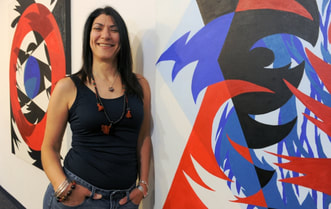
Posted Jun. 30, 2014 by Jonathan Goodman
Jewish houses of worship are not known for their inclusion of contemporary art, but the Synagogue for the Arts has done a terrific job of bringing in the paintings of Lisa Zilker, who works with colorful, often primary-hued abstract passages in her pictures. Interestingly, she is a hard-edge, non-representational painter, whose tones and forms belong to the Color Field school, which emphasizes applications of simple shapes on a two-dimensional surface.
Jewish houses of worship are not known for their inclusion of contemporary art, but the Synagogue for the Arts has done a terrific job of bringing in the paintings of Lisa Zilker, who works with colorful, often primary-hued abstract passages in her pictures. Interestingly, she is a hard-edge, non-representational painter, whose tones and forms belong to the Color Field school, which emphasizes applications of simple shapes on a two-dimensional surface.
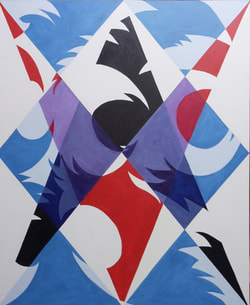
"Subtle Change" by Lisa Zilker
Zilker, who specializes in sharply outlined but never overly simple compositions, presents her pictures with genuine aplomb in this synagogue space at 49 White St., through July 23. There she addresses spirituality and formal exploration rather than devotion.
Pluralism has been a mainstream art condition since the 1970s; Zilker’s art belongs to a tradition that is by now a few generations old. It gives her a context from which to work, as well as providing her audience with a historical awareness that allows the viewer to appreciate her new efforts.
Zilker’s work, at a distance, appears hard-edged, but closer up becomes more painterly; the tension between geometric form and abstract expressiveness is one of the best things about her work. Rounded shapes lock in like a puzzle, and the colors, often red and blue, complement each other to construct a composition of genuine elegance.
These combinations of shape and hue are particularly evident in “Interior Fault,” a remarkably sophisticated and eloquent abstraction. Zilker has painted a jagged white form, much like a heraldry emblem, over a set of red and white triangles that are arranged in a rational order. The contrast between organic and geometric forms results in a dialogue that is both enjoyable to see and intellectually interesting to consider.
Zilker, who specializes in sharply outlined but never overly simple compositions, presents her pictures with genuine aplomb in this synagogue space at 49 White St., through July 23. There she addresses spirituality and formal exploration rather than devotion.
Pluralism has been a mainstream art condition since the 1970s; Zilker’s art belongs to a tradition that is by now a few generations old. It gives her a context from which to work, as well as providing her audience with a historical awareness that allows the viewer to appreciate her new efforts.
Zilker’s work, at a distance, appears hard-edged, but closer up becomes more painterly; the tension between geometric form and abstract expressiveness is one of the best things about her work. Rounded shapes lock in like a puzzle, and the colors, often red and blue, complement each other to construct a composition of genuine elegance.
These combinations of shape and hue are particularly evident in “Interior Fault,” a remarkably sophisticated and eloquent abstraction. Zilker has painted a jagged white form, much like a heraldry emblem, over a set of red and white triangles that are arranged in a rational order. The contrast between organic and geometric forms results in a dialogue that is both enjoyable to see and intellectually interesting to consider.
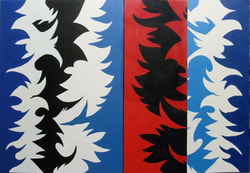
"Political Stance" by Lisa Zilker
Painting today is a bit on the defensive. Critics and curators keep announcing its demise. But an artist like Zilker infuses very good energy into her pictures, which first and foremost do what they are supposed to do: intrigue her audience. “Interior Fault” makes it clear that there is a future to Zilker’s abstraction, both for her personally and for art generally.
The most remarkable point of Zilker’s show is its consistency. The artist regularly maintains a high level of artistry from canvas to canvas. In “Political Stance,” we see a row of columns, black, white, red, and blue, some with straight edges, but most with the zigzag outline mentioned above. Again, the effect of her work is larger than the sum of its parts. “Political Stance” regales the viewer with its vibrant complexity.
The viewer recognizes from the painting’s title that Zilker is referring to the red and blue states. Humorously, she has reduced them quite literally to abstractions—which in a way the states actually are, as their red or blue color is based on their political stance, itself an emblematic representation of partisan ideology. It is extremely clever of the artist to boil down an attitude toward government to a non-figurative form!
As happens with Zilker’s pictures, her titles are just as intriguing as her art. She is a committed, highly talented painter who shows works of true intelligence and verve. Zilker deserves to be recognized within a wider context; her achievements demand no less.
The show is open to the public through July 23, 2014 Mon., Tues., Wed., 2 to 4 pm and by appointment.
http://www.tribecatrib.com/content/lisa-zilker-brings-work-intelligence-and-verve-synagogue-arts#sthash.6zjijKQx.dpuf
Painting today is a bit on the defensive. Critics and curators keep announcing its demise. But an artist like Zilker infuses very good energy into her pictures, which first and foremost do what they are supposed to do: intrigue her audience. “Interior Fault” makes it clear that there is a future to Zilker’s abstraction, both for her personally and for art generally.
The most remarkable point of Zilker’s show is its consistency. The artist regularly maintains a high level of artistry from canvas to canvas. In “Political Stance,” we see a row of columns, black, white, red, and blue, some with straight edges, but most with the zigzag outline mentioned above. Again, the effect of her work is larger than the sum of its parts. “Political Stance” regales the viewer with its vibrant complexity.
The viewer recognizes from the painting’s title that Zilker is referring to the red and blue states. Humorously, she has reduced them quite literally to abstractions—which in a way the states actually are, as their red or blue color is based on their political stance, itself an emblematic representation of partisan ideology. It is extremely clever of the artist to boil down an attitude toward government to a non-figurative form!
As happens with Zilker’s pictures, her titles are just as intriguing as her art. She is a committed, highly talented painter who shows works of true intelligence and verve. Zilker deserves to be recognized within a wider context; her achievements demand no less.
The show is open to the public through July 23, 2014 Mon., Tues., Wed., 2 to 4 pm and by appointment.
http://www.tribecatrib.com/content/lisa-zilker-brings-work-intelligence-and-verve-synagogue-arts#sthash.6zjijKQx.dpuf
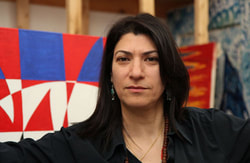
http://www.huffingtonpost.com/nancy-ruhling/astoria-characters-the-re_2_b_4716760.html
Astoria Characters: The Artist Who Draws In Nature ~ February 2, 2014
She paints. She writes. She welds. She wears men's Tony Lama cowboy boots and dangly turquoise earrings that fly through her long black hair when the wind blows. Lisa Zilker loves math, science, literature and getting her sturdy hands dirty down to her short, unpolished nails.
"There is nothing I don't do," she says. "I guess you could say I'm a modern-day Renaissance woman."
Photo by Nancy A. Ruhling
Lisa Zilker paints trees, nudes and geometrics.
But wait. Lisa whips out her iPhone, the one in the red case, and bends down in the middle of 21st Street. Before any cars come, she snaps a quickie of an old black glove.
She's obsessed with gloves, which she considers the footprints of mankind. So far, she's taken photos of 1,500 and has made a video about them.

Lisa, a polymath born under the sign of Gemini, started painting in kindergarten and has made art her life and livelihood.
"My grandfather, who liked to paint and build things, gave me my first paint box when I was five," she says. "We used to paint together."
She points toward the back of her studio, a room without a view or an air conditioner. That 8 X 11 landscape that's half out of its wooden frame is one of his. She keeps it for inspiration.
Gloves bring out the camera in Lisa.
Lisa loves her studio by Silvercup.
Growing up in Bayside, Lisa painted what she saw, which usually involved the robust sporting activities of her three brothers.
Although her parents divorced and her father returned to Israel, her mother's eventual second remarriage restored the family unit.
"My mother had easels all over the house for me," she says. "And wherever I went, I was always drawing and painting."
The painting muse tapped her at age 5.
There was never any question that Lisa would become an artist. When she graduated from Manhattan's School of Visual Arts, she began working in earnest. Collectors from around the world buy her works.
Lisa puts crushed flower petals and cow's blood in her homemade paint.
She also tells a story about some really expensive boots she had custom made.
Almost as an afterthought, she mentions an ex-husband and an ex-boyfriend and a trip to Texas where she bought a bunch of Tony Lamas on sale and drove a rental car 110 mph for three hours through the pouring rain.
That's really all she has to say about her personal life. She'd much rather talk about her work, which revolves around three interconnected and overlapping images: trees, geometrics and faceless female nudes.
"Trees are about how things grow and interact, geometrics are about earthy, planetary movement and how we interact politically, and the nudes represent all women and my feminist nature," she says. "They are about atrocities and mutilation done to women."
Lisa's studio lacks windows and AC, but she doesn't mind.
Lisa likes to make her own paint. It's a recipe of linseed oil, wax, cow's blood and fresh flower petals.
"My paint and my paintings are all about life," she says. "I tend to use a lot of blue and red. We are born blue, the color of pure energy in the universe. This means we are perfect, but we also are born in the red of blood. We die red and go into blue again."
Lisa's tree paintings are symbols of life and love.
Wait a minute. Let's back up. Cow's blood? Yes, cow's blood. She buys buckets of it from the butcher and stores it in her refrigerator.
"You never get the smell of it out of your mind," she says. "It's as fresh as if you cut it out of a vein. The DNA in the blood line transcends time."
The way Lisa does it, there's more to making paint than merely mixing blood and pigments.
Lisa and her signature Tony Lamas.
"I used to grind the flowers by hand in an old coffee can with a railroad spike," she says. "Now, I put them in the coffee grinder. I use ground graphite for the black, and soon I'm going to be using ground bark for my tree paintings."
The tree bark -- she wonders why didn't think of it before. She's not going to hurt any trees. She's going to find some that have peeling bark.
Lisa's painting and a duct-taped vent hang together in her studio.
It's the same with the flowers. She doesn't pick them. She takes the petals off bouquets people give her. Come to think of it, her friends give her a lot of flowers. She doesn't know why, but she's grateful.
Most of Lisa's work springs from her soul spontaneously; more often than not, she fingerpaints. Her thought process is like a circle of life and death. In one instance, she started drawing doors. The doors became portals, which turned into tombstones.
Lisa's feminist version of Munch's The Scream.
"Have you ever driven in the cemetery at night and seen your car headlights shine on the marble of the headstones?" she asks.
The geometrics, however, require careful planning. She sketches and re-sketches their intricate patterns.
Lisa gets so involved in her work that sometimes she doesn't leave her studio until dawn. "I like to watch the sun rise on my way home," she says.
Lisa's looking for name fame.
Someday, Lisa hopes you'll know her name. She wants to be as famous as Picasso.
But first things first. Right now, there's a tree painting on her easel waiting for her to apply the finishing touches.
"I'm going to gild the trunk and branches," she says. "I was sitting here looking at it when I felt Mother Nature come and wrap her arms around me in an embrace. Trees are life, they are love. Let me give you a hug."
Nancy A. Ruhling may be reached at Nruhling@gmail.com
All Photos by Nancy A. Ruhling Copyright 2014 by Nancy A. Ruhling
Follow Nancy Ruhling on Twitter: www.twitter.com/NancyRuhling
"My grandfather, who liked to paint and build things, gave me my first paint box when I was five," she says. "We used to paint together."
She points toward the back of her studio, a room without a view or an air conditioner. That 8 X 11 landscape that's half out of its wooden frame is one of his. She keeps it for inspiration.
Gloves bring out the camera in Lisa.
Lisa loves her studio by Silvercup.
Growing up in Bayside, Lisa painted what she saw, which usually involved the robust sporting activities of her three brothers.
Although her parents divorced and her father returned to Israel, her mother's eventual second remarriage restored the family unit.
"My mother had easels all over the house for me," she says. "And wherever I went, I was always drawing and painting."
The painting muse tapped her at age 5.
There was never any question that Lisa would become an artist. When she graduated from Manhattan's School of Visual Arts, she began working in earnest. Collectors from around the world buy her works.
Lisa puts crushed flower petals and cow's blood in her homemade paint.
She also tells a story about some really expensive boots she had custom made.
Almost as an afterthought, she mentions an ex-husband and an ex-boyfriend and a trip to Texas where she bought a bunch of Tony Lamas on sale and drove a rental car 110 mph for three hours through the pouring rain.
That's really all she has to say about her personal life. She'd much rather talk about her work, which revolves around three interconnected and overlapping images: trees, geometrics and faceless female nudes.
"Trees are about how things grow and interact, geometrics are about earthy, planetary movement and how we interact politically, and the nudes represent all women and my feminist nature," she says. "They are about atrocities and mutilation done to women."
Lisa's studio lacks windows and AC, but she doesn't mind.
Lisa likes to make her own paint. It's a recipe of linseed oil, wax, cow's blood and fresh flower petals.
"My paint and my paintings are all about life," she says. "I tend to use a lot of blue and red. We are born blue, the color of pure energy in the universe. This means we are perfect, but we also are born in the red of blood. We die red and go into blue again."
Lisa's tree paintings are symbols of life and love.
Wait a minute. Let's back up. Cow's blood? Yes, cow's blood. She buys buckets of it from the butcher and stores it in her refrigerator.
"You never get the smell of it out of your mind," she says. "It's as fresh as if you cut it out of a vein. The DNA in the blood line transcends time."
The way Lisa does it, there's more to making paint than merely mixing blood and pigments.
Lisa and her signature Tony Lamas.
"I used to grind the flowers by hand in an old coffee can with a railroad spike," she says. "Now, I put them in the coffee grinder. I use ground graphite for the black, and soon I'm going to be using ground bark for my tree paintings."
The tree bark -- she wonders why didn't think of it before. She's not going to hurt any trees. She's going to find some that have peeling bark.
Lisa's painting and a duct-taped vent hang together in her studio.
It's the same with the flowers. She doesn't pick them. She takes the petals off bouquets people give her. Come to think of it, her friends give her a lot of flowers. She doesn't know why, but she's grateful.
Most of Lisa's work springs from her soul spontaneously; more often than not, she fingerpaints. Her thought process is like a circle of life and death. In one instance, she started drawing doors. The doors became portals, which turned into tombstones.
Lisa's feminist version of Munch's The Scream.
"Have you ever driven in the cemetery at night and seen your car headlights shine on the marble of the headstones?" she asks.
The geometrics, however, require careful planning. She sketches and re-sketches their intricate patterns.
Lisa gets so involved in her work that sometimes she doesn't leave her studio until dawn. "I like to watch the sun rise on my way home," she says.
Lisa's looking for name fame.
Someday, Lisa hopes you'll know her name. She wants to be as famous as Picasso.
But first things first. Right now, there's a tree painting on her easel waiting for her to apply the finishing touches.
"I'm going to gild the trunk and branches," she says. "I was sitting here looking at it when I felt Mother Nature come and wrap her arms around me in an embrace. Trees are life, they are love. Let me give you a hug."
Nancy A. Ruhling may be reached at Nruhling@gmail.com
All Photos by Nancy A. Ruhling Copyright 2014 by Nancy A. Ruhling
Follow Nancy Ruhling on Twitter: www.twitter.com/NancyRuhling
Works by Lisa Zilker Showcased at Chester Synagogue
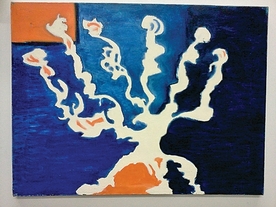
Published 01/30/2012
Press release from Congregation Beth Shalom Rodfe Zedek Menorahs, often associated with the Jewish holiday of Hanukkah, are iconic to the Jewish religion and culture. Congregation Beth Shalom Rodfe Zedek (CBSRZ), 55 East Kings Highway, Chester, will feature a fanciful collection of menorah paintings by New York artist Lisa Zilker. The show opens on Friday, Feb. 3 and will run through the third week of April. The works may be viewed Monday through Friday from 10 a.m. to 3 p.m. in the synagogue's Main Street Gallery.
Zilker's colorful paintings of menorahs, as well as other themes the artist undertakes, are first meticulously drawn out on graph paper to perfect mathematical scale before being transferred to canvas.
Says Zilker, "The interaction of color, depth of space, and emotional states continue to interest me. My most recent works have become grid-based paintings with organic and botanical shapes which are more simplified. The resulting compositions are intricate and extremely energetic."
Zilker's works may be purchased through the synagogue office. For more information, call 860-526-8920.
http://www.theday.com/article/20120130/ENT16/302029727
Press release from Congregation Beth Shalom Rodfe Zedek Menorahs, often associated with the Jewish holiday of Hanukkah, are iconic to the Jewish religion and culture. Congregation Beth Shalom Rodfe Zedek (CBSRZ), 55 East Kings Highway, Chester, will feature a fanciful collection of menorah paintings by New York artist Lisa Zilker. The show opens on Friday, Feb. 3 and will run through the third week of April. The works may be viewed Monday through Friday from 10 a.m. to 3 p.m. in the synagogue's Main Street Gallery.
Zilker's colorful paintings of menorahs, as well as other themes the artist undertakes, are first meticulously drawn out on graph paper to perfect mathematical scale before being transferred to canvas.
Says Zilker, "The interaction of color, depth of space, and emotional states continue to interest me. My most recent works have become grid-based paintings with organic and botanical shapes which are more simplified. The resulting compositions are intricate and extremely energetic."
Zilker's works may be purchased through the synagogue office. For more information, call 860-526-8920.
http://www.theday.com/article/20120130/ENT16/302029727
Press Release
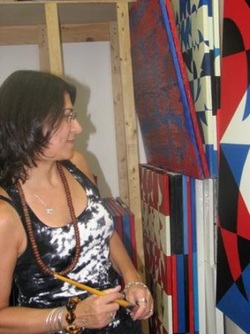
The Sylvia Wald and Po Kim Art Gallery Presents
Operating System
June 21 – July 21, 2012
The Sylvia Wald and Po Kim Art Gallery is very pleased to present the premiere of the exhibition series Operating System, a collaborative group exhibition starring a number of artists based in New York City. The reception of the premiere that features works by twenty-one artists will be held on Thursday, June 21, 2012 from 6 – 8 pm at the gallery at 417 Lafayette Street, New York, NY 10003.
Taking a cue from Kellie Jones’ criticism of art institutions and museum professionals as a disguised force attempting to define artists’ identities [Kellie Jones, EyeMinded: Living and Writing Contemporary Art. (Durham and London: Duke University, 2011) p. 106], Operating System attempts to organize a show not by an objective theme or a curatorial intention, but to structure an open platform where artists can freely express their interests and identity. This experimental exhibition series anticipates the effects of dismantling the invisible wall that stands between contemporary art and daily life on the one hand, and the wall that divides contemporary art from the rest of the arts on the other. The outcome of this experimental project is a wide range of works in different forms that are connected simply by differences, enabling such ideas as exchange, collaboration, and collectiveness.
Operating System is composed of three parts taking place at three venues over the next 6 months. This exhibition at the Sylvia Wald and Po Kim Art Gallery is the first part of the exhibition. The second part will be presented at the Dean Project from July 26 through August 16, 2012. The series finale will take place at Gallery Ho from October 11 through November 3, 2012. There will be a post-production publication documenting all installations and artworks in the series.
The premiere of Operating System features artists: damali abrams, Tomie Arai, Maria Buyondo, Karlos Carcamo, Paul Clay, Lisa Gross, Cosme Herrera, Changha Hwang, Jena Kim, Wayne Liu, John L. Moore, Odathrowback, Jin-Kang Park, Quintin Rivera-Toro, Karina Aguilera Skvirsky, Juana Valdez, Frank Webster, Seth Wulsin, Jayoung Yoon, and Lisa Zilker.
Operating System is organized by Heng-Gil Han. For more information, please contact Sumin Hing at waldkimgallery@gmail.com or at 212-598-1155.
The Sylvia Wald and Po Kim Art Gallery, 501(c)(3) non-profit organization, was founded by Korean born American artist Po Kim and his spouse, American artist Sylvia Wald. The Sylvia Wald and Po Kim Art Gallery's primary mission is to preserve, maintain and perpetuate the legacy of the founders' uniquely accomplished artistic careers and to exhibit the founders' art works to promote and widen public appreciation. In recognizing the importance of mutual understanding and acceptance between Eastern and Western cultures, the organization promotes cultural harmony through the arts by sponsoring and hosting temporary art exhibitions, dance and music performances, and other artistic events of national and international artists, known or promising. By working together with national and international artists, the organization aims to provide a catalyst for deeper intercultural dialogue between the diverse community of New York and the artistic communities of the world.
Paint the Noise
Published September 2011
Even the remotely artistic desires change – without transformation, art stagnates and drowns in past glory. The most dramatic artistic revolutions happen by force.
To say that the collective thought process of the global citizenry changed on September 11, 2001 would be an understatement – a grossly ignorant diminution of the thoughts, fears and motives of those both involved and victimized that day.
Instant 180s occurred in the minds of everyone from artists and musicians to bus drivers and zookeepers. Previously held perceptions burned and priorities were refocused and intensified.
Prior to 9/11, local Long Island City artist Lisa Zilker was working on her own issues and her priorities were on a different wavelength – then, her thoughts were invaded.
She channeled the resulting noise into the drive she needed to transform her work.
“When 9/11 happened, something switched for me,” she said. “I went back to my old way of working.”
Her first painting after the terrorist attacks, “9/18/01” (cover), is the artistic moment that she decided to expose the nuanced ways in which outside influences can force change.
“The jagged splits [in the painting] symbolize how our lives were invaded. You try to be who you are and then someone or something interrupts your thoughts and personal interactions,” she said. “Everyone wants to be in control of their own lives. The invasion happens and people lose control of their lives. Nobody wants that. It’s uncomfortable and doesn’t line up with our personality as Americans.”
Zilker’s latest work is all about conversations and interactions within society and the noise that tends to drown out what is truly being said. The artist, from her studio on 21st Street, struggles with the question of good noise versus bad noise – how is either identified and what does the noise consist of.
“This noise is based on interactions beyond our control, i.e. planetary, mental, emotional, physical and metaphysical,” she said, commenting on her current series, “Conversations between Blue and Red.” “As the grid is removed, all we are left with is the noise. Leaving us with the pain, control, order and reductionism, the practice of simplifying a complex idea, issue, condition, or the like, especially to the point of minimizing, obscuring or distorting it. This is what my focus is.”
The grid Zilker speaks of refers to her work process. Each and every project she takes on is first meticulously drawn out on graph paper – to perfect, mathematical scale – before being transferred to a grand canvas.
“The interaction of color, depth of space and emotional states continue to interest me. My most recent works have become grid based paintings with organic and botanical shapes which are more simplified – the resulting compositions are intricate and extremely energetic,” she said. “This series depicts longitude and latitude giving a sense of place – the grid – the jagged split represents noise; all types of noise.”
Painting with blue and red for a really long time, Zilker said that those two colors cover a broad swath of emotions and subject matters.
“For me those two colors symbolize politics and every possible emotion and even birth and death,” she said. “There’s an interesting dynamic between the two colors. Red is my favorite color, but politically I’m blue. They have deep meanings for me, spiritually.”
But while her processes are exact and intricate, the product is of the utmost importance.
“It’s the only way to express what I’m trying to say,” she said of her finished products. “I’ve been a perfectionist my entire life. If I’m going to do something, I may as well do it to perfection.”
That attitude also informs other aspects of Zilker’s life. Besides her own artwork, she also hosts a Podcast and has taught private art lessons. Her meticulous nature makes her a keen teacher, but it also means that she believes in her own knowledge – making authority a hindrance rather than a help.
“I haven’t taught in any public schools because I don’t want anyone to dictate what I have to teach,” she said. “It comes from my problem with authority I’ve had my whole life. You tell me not to do something and chances are I’m going to do it. I play well with others, but I am very individualistic.”
Her Podcast, “The Lisa Lisa Show,” mainly consists of running commentaries on art, philosophy, a thought of the day, history, science and basically anything that holds her interest. To give her show a listen, visit http://www.Blogtalkradio.com/lmzilker/2011/08/31/the-lisa-lisa-show. The show’s style is very free form and flows with whatever falls from her consciousness at any given moment.
And at this moment, Zilker’s consciousness directs her towards her art. She wants her work shown around the world – especially at MoMA – and she wants people to be pulled in to the art, but also wants them to take something from it. Unfortunately, the artist’s lament is similar to the writer’s lament, in that money is always an issue.
“I want to be able to do what I want. I don’t want to be locked into anything,” she said. “The problem is that I can’t find the funding to do what I want.”
But money – along with every other shallow aspect of life – is purely noise. It doesn’t enlighten life, but only complicates it and breeds headaches in those who lack its green power. Zilker said she doesn’t know where this journey is taking her, but she does believe in taking everything to its logical limit.
“It’s about getting beyond the noise of daily life and getting down to deeper conversations,” she said. “And that’s hard to do. It’s rare when you can get deeper with people because the sad truth is, most people just aren’t that deep. The noise I’m painting is the shallow nonsense of everyday life. If we can somehow get passed that noise, we can start to hear the sounds that matter.”
By Steve Mosco smosco@queenscourier.com
http://queenscourier.com/2011/paint-the-noise-29826/
Operating System
June 21 – July 21, 2012
The Sylvia Wald and Po Kim Art Gallery is very pleased to present the premiere of the exhibition series Operating System, a collaborative group exhibition starring a number of artists based in New York City. The reception of the premiere that features works by twenty-one artists will be held on Thursday, June 21, 2012 from 6 – 8 pm at the gallery at 417 Lafayette Street, New York, NY 10003.
Taking a cue from Kellie Jones’ criticism of art institutions and museum professionals as a disguised force attempting to define artists’ identities [Kellie Jones, EyeMinded: Living and Writing Contemporary Art. (Durham and London: Duke University, 2011) p. 106], Operating System attempts to organize a show not by an objective theme or a curatorial intention, but to structure an open platform where artists can freely express their interests and identity. This experimental exhibition series anticipates the effects of dismantling the invisible wall that stands between contemporary art and daily life on the one hand, and the wall that divides contemporary art from the rest of the arts on the other. The outcome of this experimental project is a wide range of works in different forms that are connected simply by differences, enabling such ideas as exchange, collaboration, and collectiveness.
Operating System is composed of three parts taking place at three venues over the next 6 months. This exhibition at the Sylvia Wald and Po Kim Art Gallery is the first part of the exhibition. The second part will be presented at the Dean Project from July 26 through August 16, 2012. The series finale will take place at Gallery Ho from October 11 through November 3, 2012. There will be a post-production publication documenting all installations and artworks in the series.
The premiere of Operating System features artists: damali abrams, Tomie Arai, Maria Buyondo, Karlos Carcamo, Paul Clay, Lisa Gross, Cosme Herrera, Changha Hwang, Jena Kim, Wayne Liu, John L. Moore, Odathrowback, Jin-Kang Park, Quintin Rivera-Toro, Karina Aguilera Skvirsky, Juana Valdez, Frank Webster, Seth Wulsin, Jayoung Yoon, and Lisa Zilker.
Operating System is organized by Heng-Gil Han. For more information, please contact Sumin Hing at waldkimgallery@gmail.com or at 212-598-1155.
The Sylvia Wald and Po Kim Art Gallery, 501(c)(3) non-profit organization, was founded by Korean born American artist Po Kim and his spouse, American artist Sylvia Wald. The Sylvia Wald and Po Kim Art Gallery's primary mission is to preserve, maintain and perpetuate the legacy of the founders' uniquely accomplished artistic careers and to exhibit the founders' art works to promote and widen public appreciation. In recognizing the importance of mutual understanding and acceptance between Eastern and Western cultures, the organization promotes cultural harmony through the arts by sponsoring and hosting temporary art exhibitions, dance and music performances, and other artistic events of national and international artists, known or promising. By working together with national and international artists, the organization aims to provide a catalyst for deeper intercultural dialogue between the diverse community of New York and the artistic communities of the world.
Paint the Noise
Published September 2011
Even the remotely artistic desires change – without transformation, art stagnates and drowns in past glory. The most dramatic artistic revolutions happen by force.
To say that the collective thought process of the global citizenry changed on September 11, 2001 would be an understatement – a grossly ignorant diminution of the thoughts, fears and motives of those both involved and victimized that day.
Instant 180s occurred in the minds of everyone from artists and musicians to bus drivers and zookeepers. Previously held perceptions burned and priorities were refocused and intensified.
Prior to 9/11, local Long Island City artist Lisa Zilker was working on her own issues and her priorities were on a different wavelength – then, her thoughts were invaded.
She channeled the resulting noise into the drive she needed to transform her work.
“When 9/11 happened, something switched for me,” she said. “I went back to my old way of working.”
Her first painting after the terrorist attacks, “9/18/01” (cover), is the artistic moment that she decided to expose the nuanced ways in which outside influences can force change.
“The jagged splits [in the painting] symbolize how our lives were invaded. You try to be who you are and then someone or something interrupts your thoughts and personal interactions,” she said. “Everyone wants to be in control of their own lives. The invasion happens and people lose control of their lives. Nobody wants that. It’s uncomfortable and doesn’t line up with our personality as Americans.”
Zilker’s latest work is all about conversations and interactions within society and the noise that tends to drown out what is truly being said. The artist, from her studio on 21st Street, struggles with the question of good noise versus bad noise – how is either identified and what does the noise consist of.
“This noise is based on interactions beyond our control, i.e. planetary, mental, emotional, physical and metaphysical,” she said, commenting on her current series, “Conversations between Blue and Red.” “As the grid is removed, all we are left with is the noise. Leaving us with the pain, control, order and reductionism, the practice of simplifying a complex idea, issue, condition, or the like, especially to the point of minimizing, obscuring or distorting it. This is what my focus is.”
The grid Zilker speaks of refers to her work process. Each and every project she takes on is first meticulously drawn out on graph paper – to perfect, mathematical scale – before being transferred to a grand canvas.
“The interaction of color, depth of space and emotional states continue to interest me. My most recent works have become grid based paintings with organic and botanical shapes which are more simplified – the resulting compositions are intricate and extremely energetic,” she said. “This series depicts longitude and latitude giving a sense of place – the grid – the jagged split represents noise; all types of noise.”
Painting with blue and red for a really long time, Zilker said that those two colors cover a broad swath of emotions and subject matters.
“For me those two colors symbolize politics and every possible emotion and even birth and death,” she said. “There’s an interesting dynamic between the two colors. Red is my favorite color, but politically I’m blue. They have deep meanings for me, spiritually.”
But while her processes are exact and intricate, the product is of the utmost importance.
“It’s the only way to express what I’m trying to say,” she said of her finished products. “I’ve been a perfectionist my entire life. If I’m going to do something, I may as well do it to perfection.”
That attitude also informs other aspects of Zilker’s life. Besides her own artwork, she also hosts a Podcast and has taught private art lessons. Her meticulous nature makes her a keen teacher, but it also means that she believes in her own knowledge – making authority a hindrance rather than a help.
“I haven’t taught in any public schools because I don’t want anyone to dictate what I have to teach,” she said. “It comes from my problem with authority I’ve had my whole life. You tell me not to do something and chances are I’m going to do it. I play well with others, but I am very individualistic.”
Her Podcast, “The Lisa Lisa Show,” mainly consists of running commentaries on art, philosophy, a thought of the day, history, science and basically anything that holds her interest. To give her show a listen, visit http://www.Blogtalkradio.com/lmzilker/2011/08/31/the-lisa-lisa-show. The show’s style is very free form and flows with whatever falls from her consciousness at any given moment.
And at this moment, Zilker’s consciousness directs her towards her art. She wants her work shown around the world – especially at MoMA – and she wants people to be pulled in to the art, but also wants them to take something from it. Unfortunately, the artist’s lament is similar to the writer’s lament, in that money is always an issue.
“I want to be able to do what I want. I don’t want to be locked into anything,” she said. “The problem is that I can’t find the funding to do what I want.”
But money – along with every other shallow aspect of life – is purely noise. It doesn’t enlighten life, but only complicates it and breeds headaches in those who lack its green power. Zilker said she doesn’t know where this journey is taking her, but she does believe in taking everything to its logical limit.
“It’s about getting beyond the noise of daily life and getting down to deeper conversations,” she said. “And that’s hard to do. It’s rare when you can get deeper with people because the sad truth is, most people just aren’t that deep. The noise I’m painting is the shallow nonsense of everyday life. If we can somehow get passed that noise, we can start to hear the sounds that matter.”
By Steve Mosco smosco@queenscourier.com
http://queenscourier.com/2011/paint-the-noise-29826/

